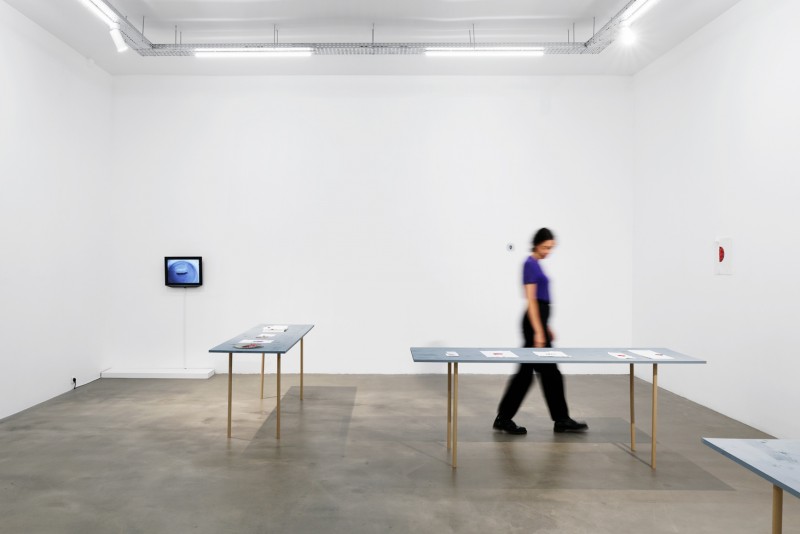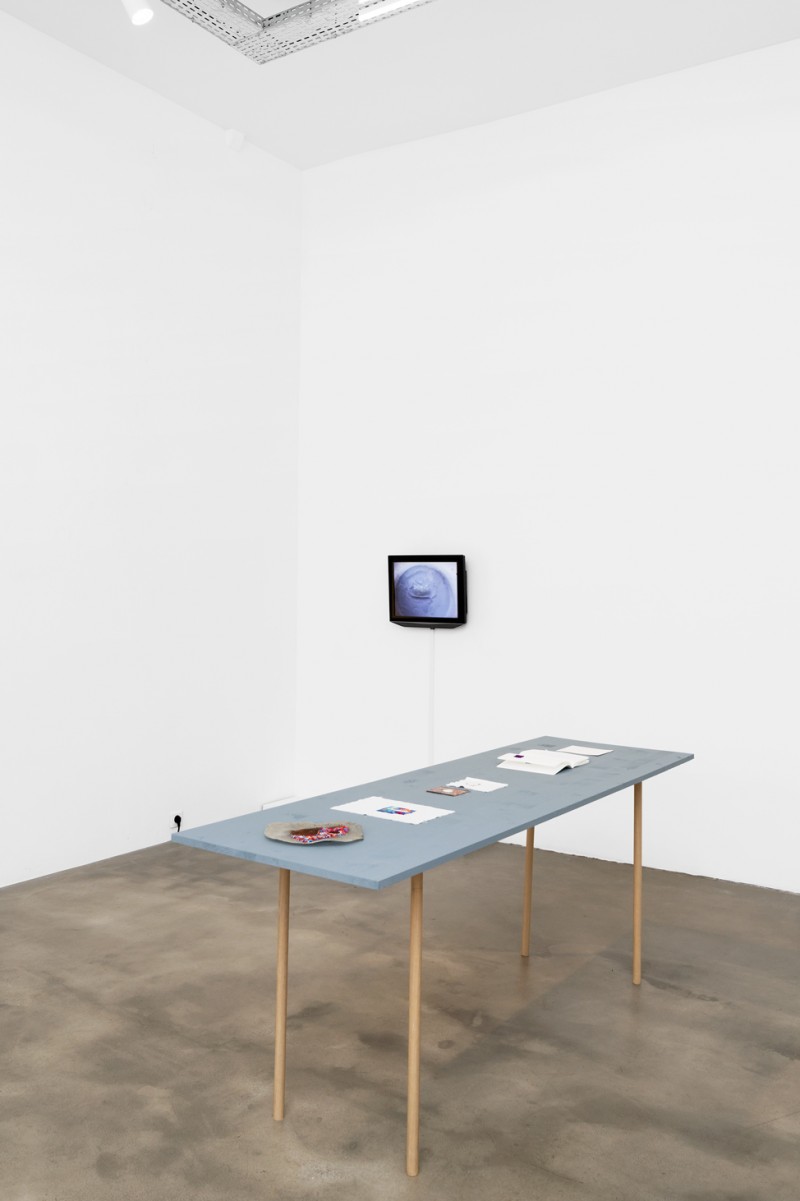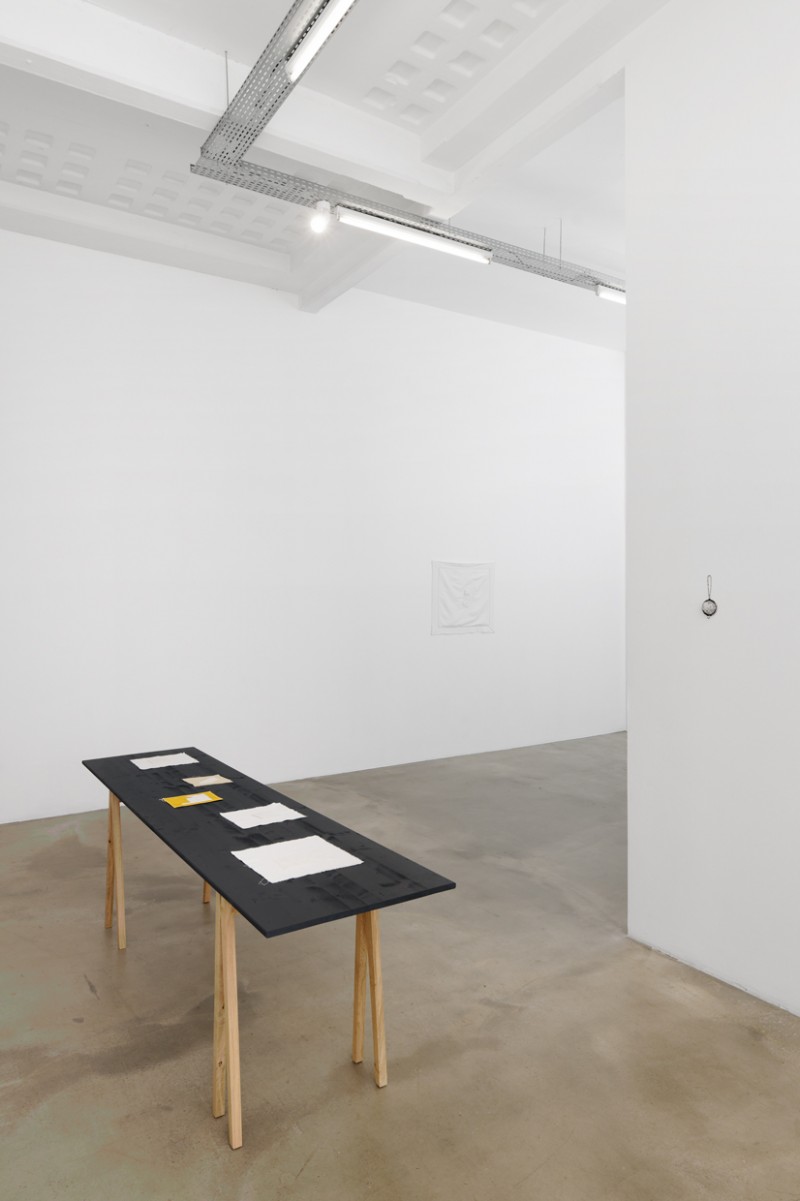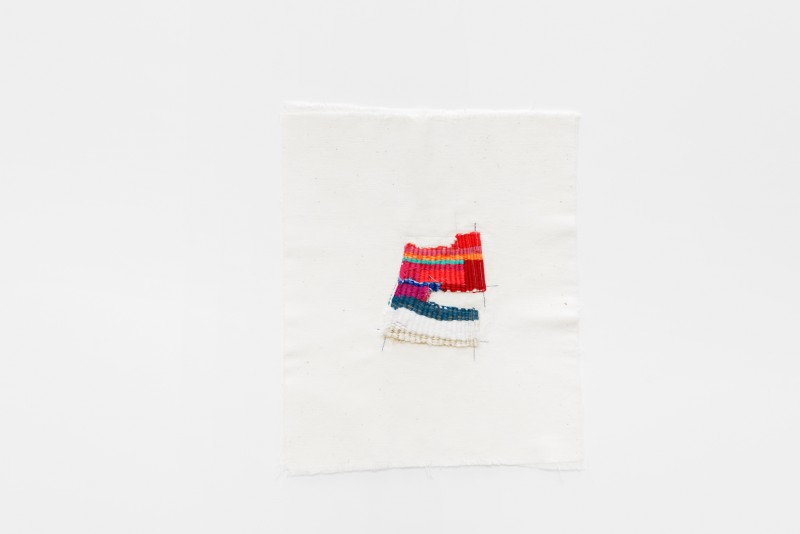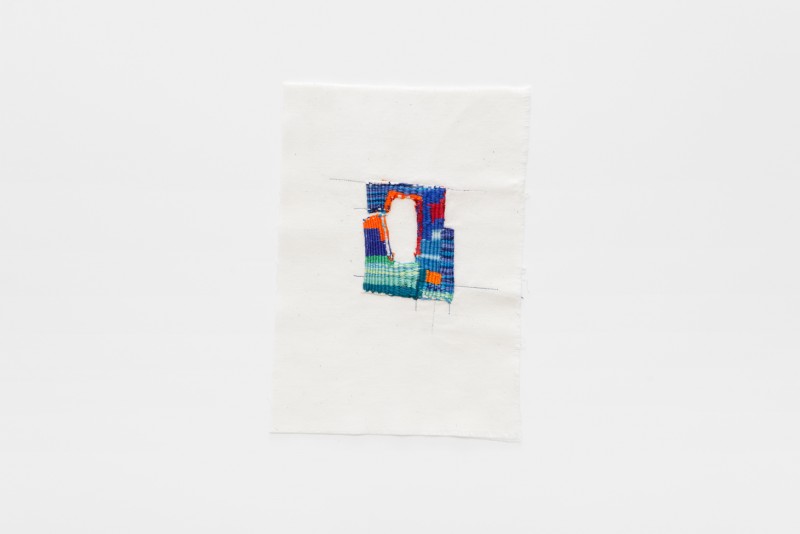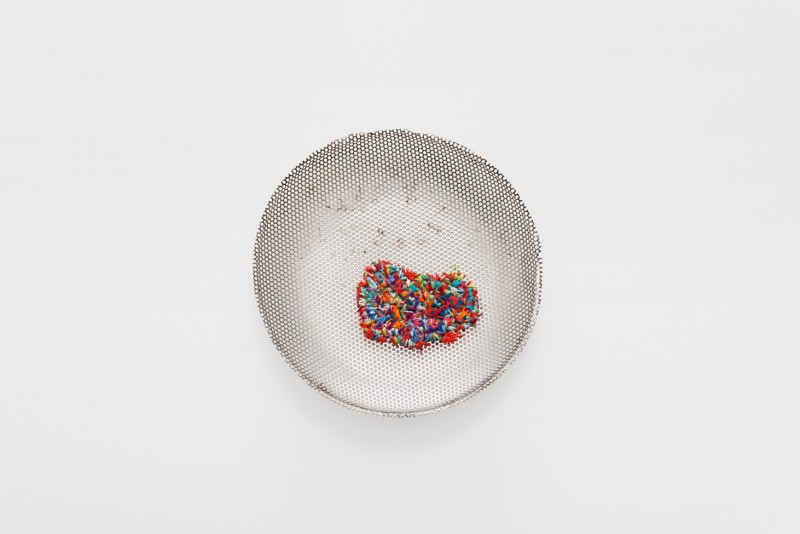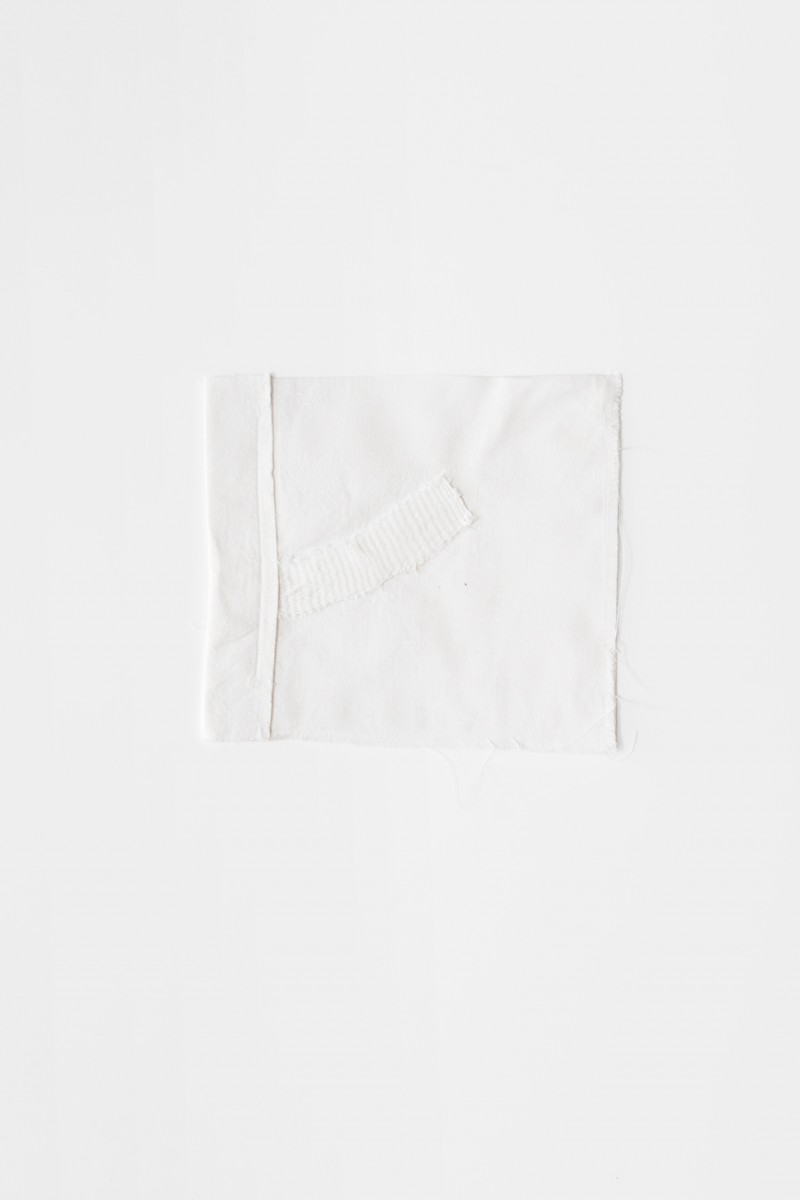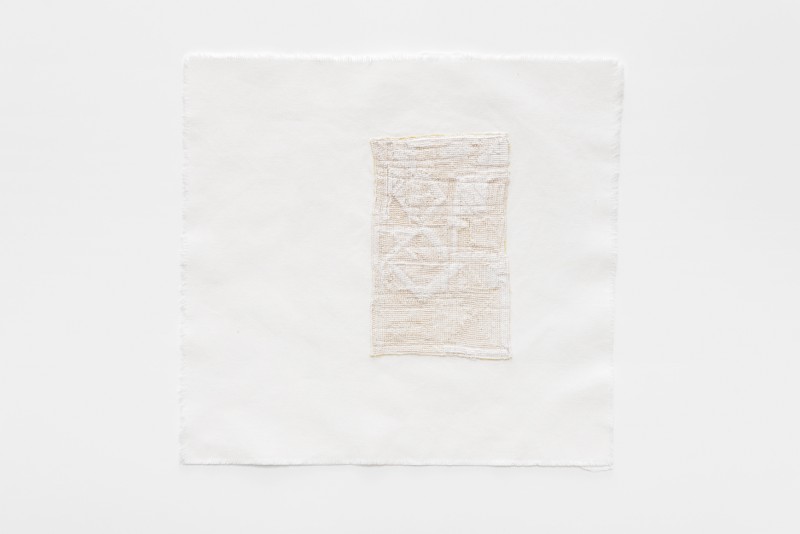Majd Abdel Hamid: 800 meters and a corridor
Solo exhibition
gb agency, Paris
October 15 - November 19, 2022
Majd Abdel Hamid’s exhibition seeks to construct a personal, intimate and collective memory of a particular day. 800 meters and a corridor projects different fictions to evoke this moment.
White Weapon
by Marie Muracciole
-
A manifest gesture in Majd Abdel Hamid’s artistic approach is perhaps the one he produces at the edge of visibility. This gesture, in the (double) sense of the term since it designates both an act that takes a stand, and a physical movement, that of his hands, is striking for being discrete and condensed. Since 2015 , the artist embroiders squares, or almost squares, in white on a white background, in small format. It sometimes turns into a rectangle or other more or less rectilinear «shapes». The resulting surface protrudes slightly from the support. The stitches used (half-stitch, cross-stitch, and other embroidery techniques), the tension and the thickness of the thread, are generating accidents of the weft –asperities, folds and gathers. The embroidered shape is sometimes cut out and then applied on another fabric, sometimes mechanically over-stitched. By activating both materiality and invisibility, Majd Abdel Hamid clearly designates one founding gesture of abstraction in painting made in 1918 by Kasimir Malevitch . He endorses this heritage with a craftsmanship that counts in the Palestinian tradition, «tying» together several iconoclasms: those of radical abstraction, and also the religious prohibitions against representing figures that in the Arab world partly explain ornamental practices. The inaugural gesture of a utopian modernity, charged with a political and social program that is today forgotten, finds a scope that its author had not anticipated: the suprematist composition is transferred to a tiny, portable scale and it has become machine-washable ; the artist grants it a third dimension, but also a supplementary sensory regime, that of the tactile. Majd Abdel Hamid literally and meticulously manipulates everything he assembles in these small objects - a material culture that is generally patriarchal and resists industrialization; a domestic practice linked to decor, to popular imagery, and, in his own culture, to a precise formal vocabulary as well as to the feminine realm. The artist attaches closely together exogenous, perhaps irreducible worlds.
-
Abdel Hamid operates this hybridisation according to the traditional protocol of the tapestry: laborious, unauspicious to effusions. The result is hypersensitive, polysemic; the narrative that is tied up in it, complex. Among other needlepoint series, the artist has produced about twenty white pieces so far– whose titles often are the countdown of the hours or days taken to produce them. It does take him time: unlike Alighiero e Boetti, Majd Abdel Hamid is not delegating. The series is entitled Son, this is a waste of time. This response from a professional embroiderer to whom Majd Abdel Hamid asked to execute white monochromes made him decide to pursue their execution himself. He is now an embroiderer, perhaps a compulsive embroiderer. He does it while in transit, in times of waiting or when in stupor - it is also a mode of deceleration, he says. If each piece hangs on a thread, his whole work is partly due to this gesture. Knowing how to waste time, on purpose, is an art (of living).
-
These knots are made into a surface through accumulation, according to the common and underrated technique hence generally attributed to the feminine - which, however, does not have exclusive rights to it. Whether as an occupation with no implications for housewives, or as ornaments easy to transport and market made by workers, embroidery has absorbed and worn out millions of eyes. In this case, the activity is since 2021 officially located in the history of Palestine, date of its inscription to UNESCO’s Intangible Cultural Heritage. Each articulation between pattern, stitch, color and textile pieces, refers since the 18th century to precise places and occasions. For the colonized or exiled people, this tradition has taken on an additional meaning. It carries with it the lost territory, the places occupied by others, the destroyed cities, villages and houses. The weight of the loss, of the multiple forced or forbidden displacements that result from it, are proportionally inverse to the lightness of the threads and the work that puts them together. Displacing these motifs, reinvesting them or inventing others as he travels through a devastated region (from Damascus, where he was born; Ramallah, where he grew up; and Beirut, where he has lived for the past few years, three nodes of geopolitical violence from which Europe is neither absolved nor unscathed, and to which the war in the Ukraine offers one more stage) also constitutes a gesture. The early Screenshots series (2015) was transposing the pixels of images of violence from the war in Syria into the grid of an ordinary canvas, embroidered with half-stitches, thus diminishing the definition and therefore the reading of documents coming from social media. A Polaroid taken on the Beirut waterfront, detail of the coastline at the end of the land «reclaimed» from the sea by an accumulation of ruins, waste and, it is said, mass graves, is the starting point of a new motif since the unrepresentable explosion of August 4, 2020. A motif that Majd Abdel Hamid has intuitively declined until he finds a plan of the city that it he had not foreseen.
-
Make no mistake, Majd Abdel Hamid’s work is not about repairing history, nor even about celebrating reparation - which is all the more crucial in this time of unresolved conflicts and crisis. He does not pull the threads from an inextricable situation whose outcome does not appear imminent. The Borderlines series is the most explicit manifestation of this. In these imbroglios, the multicolored embroidery cottons accumulate “borders” without order until they form protuberances. The final tangle seems to reveal a palimpsest, the unresolved time of the clashes of history - superimposition and entanglement of painful facts and destructions that lead to the thickness of the knots, to their tightening, until they form a bulge like a failed scarring. This series, absent in the exhibition, points to the increasing thickness given by Majd Abdel Hamid to his stitches, and reminds us that Penelope was very capable: knots are easier to tie than to untie. Odysseus’ wife stands up to industrial modernity - there is no such thing as an untangling machine. Majd Abdel Hamid says that his embroideries are less and less regular, that they have lost their «prudish», smooth and standardized path. And that there is no possible repairing of the disaster. Stiches, sutures: keifa naltaïm? (how to heal?) asks a graffiti in Beirut, seen on another Polaroid. These images, condemned to fade and erase, are . Majd Abdel Hamid’s way of taking notes. He looks up at details - a light bulb filled with water, a beautifully damaged billboard, a white sheet drying at a window upon which he sets his gaze and initializes his memory (Muscle Memory). He also records work methods, in particular the stages of the long process of washing fabrics that he has dyed in indigo. In Palestine, clothes were dyed with this almost-black pigment when a relative died, then the color would fade with each washing, revealing the embroidered patterns as the mourning progressed. Polaroids, on the other hand, will all become white monochromes one day.
-
A recent sketch, 800 meters, refers to the countless stitches performed in people after the August 4, 2020 explosion at the port of Beirut, which mutilated a city and population already devastated by the summer 2019 crisis and the years of corruption that preceded it. Wounded, his head stitched up and still in shock, Majd Abdel Hamid interrupted the white rectangle he was working on and set about three more embroideries before finishing it, his wrist swollen. The irrepressible need to repeat a gesture in response to an unspoken anguish is all about compulsion – the unstoppable need to repeat a gesture. This automatism solves nothing and constitutes in its turn a form of anxiety. An operation of filling up time, the compulsion transposed into an artistic gesture builds an object all the more charged with meaning that it delivers no explicit message - there is no enunciation regarding its mechanism, which is a trauma. Trauma takes other paths than those of language, a concern that Eva Hesse powerfully reversed by transposing it into an artistic gesture. Her sculptures both cite and contradict the geometric exactitude of the minimalist sculptures of which they are contemporaries, inflicting a “natural” distortion on the abstraction and neutrality of the forms. The plasticity of the materials -resin, latex- allows Hesse to associate repetition and organicity from replicated volumes that the material alters. Each time, the principle of a formal normativity is put in check. Modified by the metamorphoses of the living and the effects of the entropy, the forms resist the principle of identity - the only repetition is death. This tension, which refers to the body and, in Hesse’s case, to the trauma of the Second World War, activates meaning through the sensorial.
-
There are accidents in history whose sound echo far away, even before they happen: Beirut was already down when the nitrate exploded, the product had been in the port for a long time, the Syrian regime had already benefited from it. The waves of shock preceded it, the story unfolded and rewinded simultaneously: unrepresentable and all-powerful. Majd Abdel Hamid asked various friends to draw a map of their safe space, the place where they feel safe: a corridor, staircase, a void under a piece of furniture. The hierarchy of the places that reassure us can be surprising, in any case it is illusory. Plans, maps, entrances and exits, figures of space for the body, to physically redirect yourself? It’s silent, it’s all in the head, nevertheless crucial when one loses one’s territory, or when history irradiates Chronos. Metabolizing a shock takes time. You have to lose this time so the motives of desire can reveal themselves back. And still they can be imperceptible. Monochromes.
Marie Muracciole, Paris, 7 octobre 2022.
